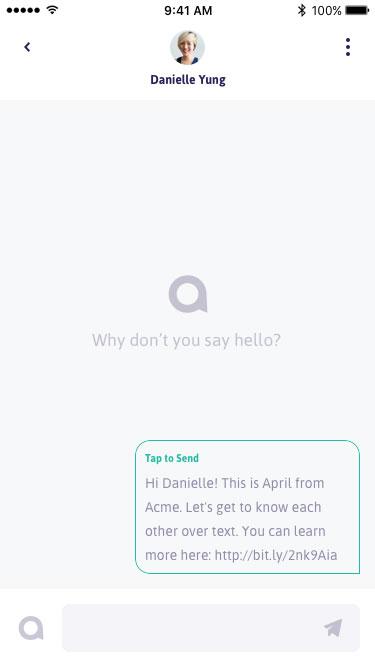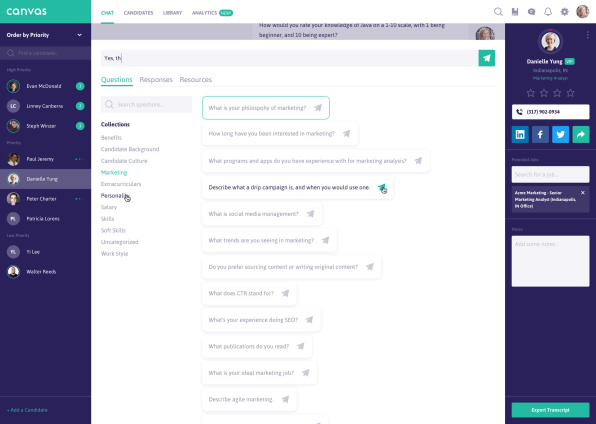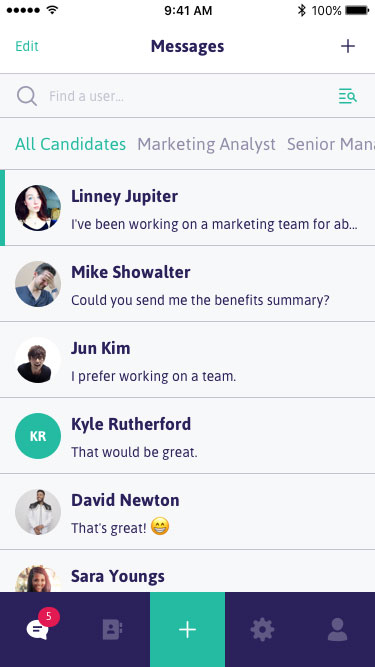what to put in the message box when applying for a job
The other day I got a text from Clara Banks, suggesting we get to know each other better. She wasn't looking for a date. Banks is a recruiter at a startup called Barksy. She sent me a link then I could learn more.
Clicking the fleck.ly link took me to a short video that walked me through how Barksy is using a platform called Canvas to text with potential job applicants. The 60-second video showed a young woman getting texts from a recruiter while she was commuting, at a cafe, or at the gym. Their chat was the basic stuff of initial screening interviews similar "tell me about your experience" and gave the candidate an opportunity to ask questions, too. By the finish, the recruiter was request to gear up upwardly a phone interview.
When I was done watching the video, Banks texted again: "Can you tell me a niggling bit more nigh yourself?" Because I've written about the use of artificial intelligence like chatbots in recruiting, I immediately idea I'd try to to run into if I was dealing with a real person. I texted back: "I'yard allergic to dogs. Tin you tell me what your benefits are similar?" Banks responded with some other link that led to a short synopsis of the company's benefits package.
At this bespeak, Banks could have kept me texting, but the human at the other stop of the mobile wasn't actually her. It was Aman Brar, CEO of Canvas, and the purpose of this item chat was to illustrate how texting enables recruiters to screen more chore candidates and market employers' brands. The platform officially launches today, although existent companies take been using it for months. One of these early adopters is a recruiting agency who reported that the speed and agility of texting is central. Brar says they've been able to screen ten times more candidates daily with the platform.
The manner information technology works in real life is pretty similar to what I experienced. The difference is that if I were an actual candidate applying to a company (Barksy is fictitious, too) the recruiter could take taken me through a portfolio of interview questions via text. I would also have had the opportunity to ask more than detailed questions most the company, the job responsibilities, piece of work hours, etc. The recruiter tin can use the desktop or the Canvas mobile app version—available on iOS and Android—to facilitate the interviews.

While Brar points out that this is completely a human conversation, there is a component of artificial intelligence at play on Canvas. For example, when I asked about benefits, recruiter Banks got a prompt from the organisation with the shortened link to send me. Bit.ly links can exist tracked, and so they can encounter if I opened it. Depending on where the chat goes, the recruiter would as well receive prompts for "recommended questions" such as "How would other people depict your leadership style?" from Sail's library. These can be customized to adapt the employer.
Canvas has another fourth dimension-saving characteristic in that the transcript of the text conversations can exist sent to hiring managers in their entirety, or they can be summarized. Brar showed me how the recruiter can requite a thumbs up or down to individual answers and the platform provides an overall score for the candidate. Recruiters can choose to share the scores or not; it's upward to them.
But Canvas isn't but built for speed. Brar notes that reaching candidates by text could solve the larger trouble of getting someone–either the candidate or the recruiter–to answer at all. The hiring process now takes longer than ever, according to Glassdoor, and half of applicants surveyed by Talent Board said they never heard dorsum at all after submitting their resumes. A recent survey from Yello suggests that employers are going about contacts with job seekers all wrong. Out of the more than 1,400 adults under xxx surveyed, 86% reported feeling positive about getting text messages during the interview flow. Couple this with the fact that Nielsen establish that texting is the most used data service in the world with an estimated eighteen.7 billion texts sent worldwide every day (non including app to app).
Although Brar cites the staggering number of millennials who will brand up the workforce by 2025 he says it'due south not merely digital natives who will readily respond to recruiters' texts. "I would have never guessed a recruiter in the manufacturing infinite would exist our beginning client," he says. He also notes that Canvas signed a larger wellness intendance system that'southward hiring a lot of nurses. "These are people who are hard to become to during the day," he says, as some work second or third shift. Texting, he maintains, "is a lighter enquire than, 'hey can we have a phone call?'"
As for getting those mobile numbers from candidates, virtually resumes include them. As for passive candidates who aren't actively seeking a job, just might be persuaded if the correct offer comes forth, Brar says, "Recruiters are sourcing past the aforementioned methods they traditionally have,' like college campuses, task fairs, etc. "Once they are ready to appoint they become the mobile numbers," he explains, "It's very authentic and organic. We don't impact the sourcing."

Of course, it's to be expected that this communication is asynchronous if a person is in the eye of their workday. Brar says it's up to the individual recruiter when to ship messages to applicants. I asked if a recruiter could be biased if the job seeker doesn't respond right away. He admits that it's possible, but points back to that initial video candidates get equally part of their introduction. Brar says the messaging on the video is purposefully laid back, using linguistic communication like "no force per unit area" to make candidates feel at ease if they can't text back immediately. He also says that an upcoming feature in Canvas will exist the ability to mask candidates' names, like to the way Blendoor and Interviewing.io either mask or change qualifying information (like vocal tone) so that hiring managers' decisions won't exist colored by implicit bias.

Brar won't discuss how many job applicants take been placed since clients have started paying for the platform (which ranges from a few hundred to a few g dollars a month, depending on the size of the company). He does say that at one company in that location's already been virtually v,000 letters sent through the platform and the response rates are what impressed him.
"Recruiters making 30-50 outbound connect with 5 [people]," he says, which works out to about x%. This particular client had a response charge per unit of l% for this customer. "Imagine if the only selection to connect was through voice calls," he says. Information technology would be impossible to become the same kind of scale, especially because that some positions garner hundreds of applicants. Fast Company recently reported how 1 man applied to 538 jobs over about a iii-month period.
The most surprising thing that's surfaced from early adopters using the platform is the level of professionalism the candidates take shown. Texting ways dissimilar things to different people, so potential for the recruiter to receive a bulletin that doesn't use proper grammar and punctuation is loftier.
Ane vice president of HR reportedly asked Brar what to practice if they send an emoji or spell you lot equally "u" instead of typing out the whole word.
Ultimately, says Brar, "You lot are in a tight labor market and if the worst thing that happened is your candidate treated you like a friend, I don't think that'southward a bad thing." He says the CEO of that company agreed. He does argue that Canvas texting is just one way to sympathise a person and help them get to the side by side level. "You wouldn't ally someone after just a text interaction," he quips. "We want to support homo to human interaction."
Source: https://www.fastcompany.com/40430019/what-its-like-to-apply-for-job-over-text
0 Response to "what to put in the message box when applying for a job"
Publicar un comentario